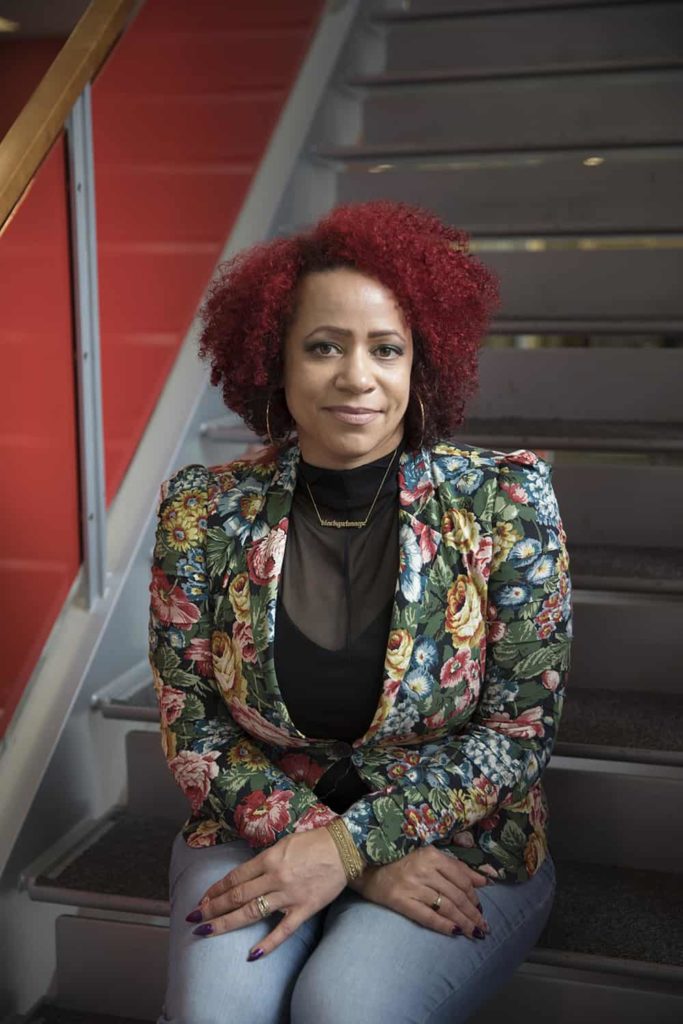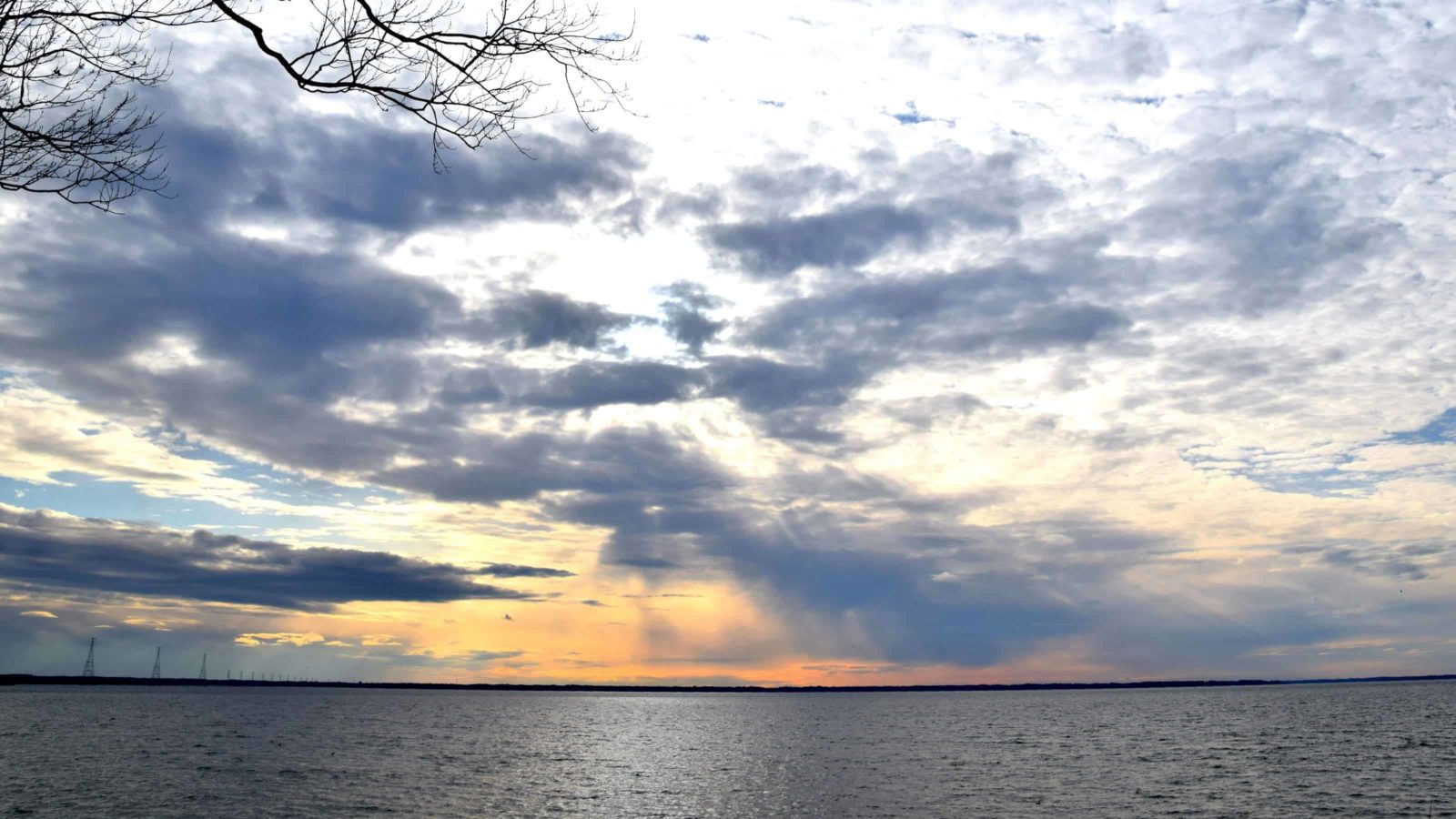In 1619, 20 to 30 men and women and children walked onto the shore near the mouth of Chesapeake Bay. They came from what is now Angola on the west coast of southern Africa.
When they stepped onto this land with its salt marsh and bald cypress, they had spent weeks in the heat and stink of the ship’s hold, thirsty and starving. Many of the people with them died on the crossing. They would have worn shackles, even the children.
They were the first enslaved African people to come to what would become the United States, the first recorded in a British colony.
Last summer, 400 years later, Nikole Hannah-Jones asked the country to think about this moment. On August 18, 2019, she launched the 1619 Project in the New York Times Magazine.

Nicole Hannah-Jones portrait after winning a MacArthur grant.
The project sets out to look clearly at slavery and the many ways black Americans have fundamentally shaped this country, she explains in its opening.
She is a nationally awardwinning investigative journalist and staff writer for the New York Times, and before that for ProPublica in New York, and she has won wide acclaim for her radio reporting on This American Life. And Neil Roberts, chair and associate professor of Africana Studies and W. Ford Schumann Faculty Fellow in Democratic Studies at Williams College, has invited her to campus to give a talk on Wednesday, February 26, at 7:30 p.m., at the ’62 Center, with a conversation and Q&A. The event is free and open to all.
“She is talking about democracy,” he said in his office at Williams, while snow fell quietly outside. “And about the relationship between race and democracy.”
She has a celebrated career, Roberts said, and she is deeply historically informed. He has invited her to come to campus as part of Recent Democracy series of events. Since August, he said, the 1619 Project has grown and expanded into conversations across the country, and into secondary schools, colleges and universities.
“We all have a lot to learn from the Project,” he said. “… The project explores the question of how we understand and interpret history.”
Slavery has existed from the country’s beginnings, Hannah-Jones writes, while the country has held up an ideal of freedom. That tension has shaped its founding and its core structures. It has even shaped the buildings. Enslaved and free African-American workers built the White House and the capital building in Washington, D.C.
At the same time, Hannah-Jones, affirms, black Americans have set strong hands to build the country’s economic strength, industrial power, public health, education, legal system and more.
She was not taught this perspective as a student, she writes. She has learned it herself, pieced it together in her writing and research and gleaned it in the example of people she loves, beginning with her father: “He knew our people’s contributions to building the richest and most powerful nation in the world were indelible, that the United States simply would not exist without us.”
She celebrates many of those contributions in her essay in the New York Times Magazine, and in the essays, fiction and poems she has curated here.
Mary Elliott and Jazmine Hughes set out to give a concrete history of slavery’s 250 years in this country. The men and women who came to the Chesapeake in 1619 came most likely from the kingdoms of Ndongo and Kongo, they write in their essay in the magazine.
These people forced away from home were not the first enslaved Africans to come to the Americas, Roberts said. He emphasizes, as Hannah-Jones writes: traders or pirates had taken them from a Portuguese ship — the slave trade between Africa and the Americas was already in place.
In his work on the Caribbean, he said, scholars see 1492 as the date that begins the European presence. But in U.S. history,”if we disavow or silence the 1600s, we don’t pay attention to a huge foundational period.”

Sand shelves down to the water on the coast near Jamestown, Va. Creative Commons photo courtesy of Scott Neville, Washington Post
The 1619 Project’s writers make this history tangible in objects and places. A child’s shackle would chafe and abraid a small ankle.
They find the locations of slave markets and auction blocks that stood at town centers up and down the country, including in Massachusetts, and on Wall Street.
Then Hannah-Jones and her fellow writers move forward to contemporary debates. They make connections in healthcare, public transportation, farmland, the brutal work of sugar production.
And at the same time they show black Americans working to change that contradiction at the center of the country’s history, the debate over democracy and freedom.
That debate goes on today, Roberts said — can democracy and freedom live symbiotically? Is there a tension between them? Scholars in his field debate whether these structures can change.
The debate has gone on for centuries.
He recalls Frederick Douglass giving his 4th of July Address to the Rochester Ladies’ Anti-slavery Society in 1852, and beginning it: “Fellow Citizens.” Douglass had escaped slavery in Maryland, Roberts said, and he could have been brought back. The Supreme Court had made that clear in the Dred Scott Decision: His people had no rights. He speaks that day knowing it is unclear when they will ever become citizens.
Within 20 years, they do, at least on paper in the Constitution. Black congressmen in the 1860s and 1870s were instrumental in creating the system of public schools in this country, Hannah-Jones writes, and in defining the rights of citizenship.
But for decades afterwards, she explains, they could not exercise those rights.
“At 43, I am part of the first generation of black Americans in the history of the United States to be born into a society in which black people had full rights of citizenship. Black people suffered under slavery for 250 years; we have been legally ‘free’ for just 50.”
And yet Hannah-Jones’ father had served in the army, and he flew an American flag in front of their house.
“At a Jim Crow moment,” Roberts asked, “how can you raise a flag and make a claim as an American?”
He thinks of Berkshire-born writer, professor and internationally influential activist W.E.B. DuBois, who wrestled with this irony for 95 years — how to be a black man and an American, how live and think and love and work fully in this country.
In the opening of Souls of Black Folk, DuBois looks across a history, and at his present in 1903 of sorrow songs and lynchings, share croppers and children in a one-room schoolhouse … and he asks, “How does it feel to be a problem?”
Hannah-Jones looks ahead in response. The 1619 Project talks with recent graduates at Fisk University planning careers in environmental law and starting fellowships at the ACLU. It honors Black artists and performers who have defined powerful and popular movements in music and culture and language.
And she asks: “What if America understood, finally, in this 400th year, that we have never been the problem but the solution?”
Up close
What: Nikole Hannah-Jones: Reflections on 1619 and the 400 Years that Built a Nation
When: 7:30 p.m. Wednesday, Feb. 26
Where: Williams College ’62 Center for Theatre and Dance, 1000 Main St., Williamstown
Admission: Free — but tickets are required from the box office or online
Information: 413-597-2425; williams.edu
This story first ran in the features section of the Berkshire Eagle. My thanks to features editor Lindsey Hollenbaugh.

